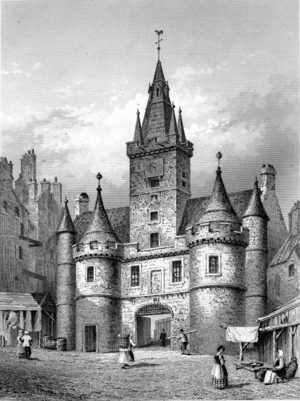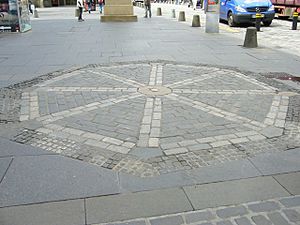John King (Covenanter) facts for kids
Quick facts for kids John King |
|
|---|---|

|
|
| Orders | |
| Ordination | Clandestinely at Port of Menteith |
| Personal details | |
| Died | 14 August 1679 market-cross Edinburgh |
| Denomination | Church of Scotland |
John King was a brave Scottish minister who lived in the 1600s. He was part of a group called the Covenanters. These Covenanters believed in a special way of practicing their Christian faith. Because of his beliefs, John King was considered an "outlaw" by the government at the time. He often had to hide and preach in secret meetings called "conventicles." He was even a chaplain, or religious advisor, to a nobleman named Lord Cardross.
John King was captured by soldiers led by Claverhouse after a fight called the Drumclog skirmish. He was taken to Edinburgh with another preacher, John Kid. Both men faced harsh questioning and were sentenced to death. After he died, parts of King's body were displayed at the Netherbow Port in Edinburgh, near James Guthrie's skull.
Contents
Life as a Covenanter
John King was an important figure during a tough time in Scottish history, especially around the battle of Bothwell Bridge. He worked as a chaplain for Henry, 3rd Lord Cardross. In 1674, King was arrested for holding secret religious meetings, known as conventicles. Lord Cardross was thought to have helped him.
King was brought before the Privy Council, a group of important government officials. He was released but had to promise to appear again if called. In May 1675, soldiers arrested him again at Lord Cardross's home. The next day, many local people from Menteith and Kippen gathered. They bravely rescued King from the soldiers.
Lord Cardross was not home during the arrest. But when he heard about it, he complained to the Privy Council. They investigated and decided that Lord Cardross had helped with the rescue. Because of this, he was sent to Edinburgh Castle. He also had to pay a large fine. Soldiers tried to catch King again in June 1675, but he managed to escape. One man, Norrie, was killed while trying to protect the preacher.
Just before the Drumclog skirmish in June 1679, King was captured in Hamilton. This happened on May 31, and fourteen other people were also taken by Colonel Graham of Claverhouse. Some people who escaped from Hamilton headed towards Loudoun Hill. A large outdoor religious meeting was planned there. This led to the fight at Drumclog. On Sunday morning, June 1, Claverhouse set out to break up the meeting. He took King and the other prisoners with him, tied together.
After the Drumclog Battle
After Claverhouse's soldiers were defeated at Drumclog, the Covenanters chased them. They freed King and the other prisoners. King then tried to go to the Isle of Arran. However, he was caught again using a trick on the Blair estate in Ayrshire. This happened shortly after the Covenanters lost the battle at Bothwell Bridge.
King was then taken to Edinburgh. One of the soldiers guarding him was asked where they were going. He supposedly replied, "To carry King to hell." On the same day, that soldier was accidentally killed by his own gun.
King's Trial
After the battle of Bothwell Bridge, King was captured again with another preacher named Kid. They were both brought to trial. King appeared before the council on July 9, 1679. He and John Kid argued that they were forced to be with the rebels. They said they did not take part in the fighting. They also claimed they refused to preach to the rebels and escaped as soon as they could.
But their pleas did not help. They were both subjected to painful questioning methods. Then, they were sentenced to death. After several court appearances and a failed attempt by their lawyer, they were officially condemned.
John King's Writings
John King's final speech, given just before he died, was printed. In this speech, he mentioned his wife and one child. The only sermon by him that we know of is in a collection put together by John Howie.
Inspiration for a Character
Sir Walter Scott, a famous writer, created a character named Gabriel Kettledrummle in his book Old Mortality. Many people believe this character was based on John King, though it's a changed version. One writer, Thomson, noted that King's actual sermon and last speech were very different from Scott's fictional character. King's real words showed his strong faith and wisdom. This means Scott likely used his imagination more than facts when creating the character of the fanatic preacher.


